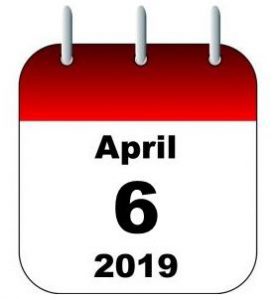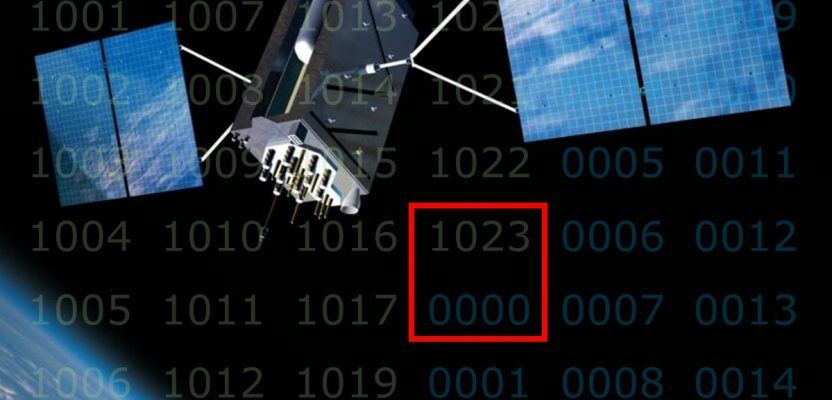Updated March 28th, 2019: Unavco, the science cooperative that supports such projects as the Earthscope PBO GNSS and geophysical senor arrays, has launched a comprehensive WNRO page that addresses many of the receiver types they have deployed and includes some of their own tests. Updated March 26th, 2019: Trimble and Topcon have added updates to their respective WNRO pages (see below).
Don’t panic, but …
What is the GPS Week rollover and why is it of interest (or concern) to GPS users? GPS typically works so wonderfully for so many uses because, on the surface, it seems as simple as receiving data from multiple satellites and resolving positions in your receiver—without pain or anxiety—whether your receiver is a cheap chip on a cell phone or a high-precision, high-ticket survey rover.
The signals, codes, and messages of GPS (the U.S. Navstar constellation—this does not affect the other GNSS constellations) had been brilliantly designed for efficient transmission. One element, as defined in the legacy GPS navigation message (LNAV, ICD-200), uses 10 bits to count GPS Week Numbers with a limit of 1024 numbered weeks, or a little under 20 years, before rolling over to a new “week zero.”
 The second scheduled GPS week number rollover (WNRO) will occur, according the rollover info on gps.gov, at 18 seconds prior to the 0000Z boundary (Coordinated Universal Time) between April 6 and 7, 2019—around midnight GMT, or Saturday afternoon of the the 6th in North America. If a GPS receiver is running firmware or software that cannot resolve that calendar ambiguity, it could have a flashback to 1999—the time of the first cycle of 1024 weeks from the 1980 zero week.
The second scheduled GPS week number rollover (WNRO) will occur, according the rollover info on gps.gov, at 18 seconds prior to the 0000Z boundary (Coordinated Universal Time) between April 6 and 7, 2019—around midnight GMT, or Saturday afternoon of the the 6th in North America. If a GPS receiver is running firmware or software that cannot resolve that calendar ambiguity, it could have a flashback to 1999—the time of the first cycle of 1024 weeks from the 1980 zero week.
If you remember the 1999 WNRO, odd articles in consumer tech publications claimed that it could be “worse than Y2K!” (guffaw!). But there were real instances of receivers that thought they were back in 1980, causing issues that were troubling but nowhere near as problematic as the dire predictions.
Here is the good news in short form: almost without exception, gear sold since 1999 is (or has been updated to be) “compliant” with the 2019 WNRO. Note that if any RTN (real-time network) of any kind is comprised of varied brands/models of receivers, the respective network operator would need to check for compliance of each type. It is rare though that any RTN is running any legacy or non-compliant receivers. Other good news is that this does not affect any other constellations, and further that GPS modernization plans include adding a 13-bit message, that would not be limited to 1024 weeks like the legacy 10-bit message. Instead, the 13-bit message would not require a rollover for 157 years.
Users concerns: The primary concern of GPS end users (that we often hear) is of course: “Will my receiver stop working properly after the rollover?” Most users are confident in the highly skilled engineers who design and develop their high-precision GPS/GNSS rovers who have taken steps to ensure there are no ill effects of the WNRO on their gear. But it can be hard to reconcile such confidence with the sometimes-ambiguous messaging they get through some of the respective sales folks about WNRO, leap-seconds, etc.
Users (speaking among themselves and on forums) decry the blanket responses of “upgrade your firmware,” which can, and often does, get viewed as over-simplified and perhaps sales-serving. Of course, it is a best practice to keep one’s gear up to date, for not only constellation and signals changes but to take care of unrelated bugs and to take advantage of new features—but folks like to do updates as schedules and resources permit and do not want to have to jump into action over uncertainty about things like the WNRO.
We asked users what kind of response would be most reassuring, and most responded that they wish there were official statements issued and/or that they could hear directly from GNSS engineers.
We’ve reached out to the manufacturers of survey-grade GPS gear—and asked if we could hear back from respective engineering/developer teams—with questions about what receivers and respective firmware would be okay. We’ve received several responses by the time this post first went live, and we’ll post more on this page as we receive them before the rollover.
Note about OEM/embed receivers: while our inquiries about the WNRO were focused on receivers for surveying/construction, we have received tech notices about OEM/embed boards built for other uses. Example. If you have OEM boards or embed components we highly recommend contacting the respective manufacturers for WNRO information.
Responses (concerning surveying and construction receivers) though, have been similar: If you have modern gear, say 2003 or newer, then you should have no issues at all. That does not mean legacy, pre-2003 gear will be rendered “boat anchors,” as some had weathered the 1999 WNRO just fine, and users have found ways to edit affected Rinex observation files manually or with scripts for post-processing. Most suggest that users consult tech bulletins and firmware release notes for their specific makes and models. Here are the responses so far, in the order received.
Trimble
Update, March 26th, 2019: Trimble has updated a dedicated WNRO page with comprehensive lists of specific models and firmware by product categories. Update, March 7th 2019: Trimble has published a support note with a list of specific models and recommended firmware versions.
First to respond was Stuart Riley, director of engineering and fellow at Trimble. When asked if there is cursory rule of thumb for WNRO 2019 compliancy, Riley said, “It really depends on the age of product. Narrowing this to geospatial [surveying and mapping] and adjacent markets [construction], all the things we currently sell—and have for a long time—will be fine. However, if you go back into the distant past with the pre-1999 4000, 4700, 4800 and other platforms [of that era]—we do expect these receivers to experience WNRO issues where the date is displayed incorrectly.”

Stuart Riley – Trimble
“With a broad brush, say if you have a 5700 or 5800 [referring to Trimble products] with the latest firmware version, they are going to be fine. And as for anything we’ve released in the past 15 years or so such as the R8, R10, NetR5, NetR9 [and other receivers with similar prefixes] etc.—they are WNRO compliant—they were not shipped without being compliant.” Riley said Trimble performed extensive testing on currently supported receivers using GPS simulators. The testing included scenarios for receivers operating during the rollover as well as receivers that were not operating but turned on after the event.
Here are Trimble’s written responses to the questionnaire we sent to manufacturers:
Q. Would any effects be model/firmware dependent (i.e. are there specific FW cutoff dates)?
A. Trimble business areas with GNSS products such as Geospatial, Real Time Networks, and Integrated Technologies plan to release support notes with product-specific information, including minimum required firmware versions. [Ed: Check on the support site for your specific model.]
Q. Issues with real-time positioning services?
A. Autonomous, DGNSS, SBAS and single baseline RTK positioning modes have been tested with simulators to verify that the WNRO is handled correctly. VRS software (Trimble Pivot Platform and older generation GPSNet software) have been tested with simulated rollover data for tracking, storage and correction output, plus software code review (for Trimble Pivot Platform) for relevant sections. Result: No issues are expected. We expect no WNRO issues with Trimble RTX or Trimble VRS Now. WNRO is a receiver issue and the receivers in the Trimble networks are WNRO compliant.
Q. What about OEM boards used in survey/construction/mapping receivers (e.g. BDxxx)?
A. Trimble’s Integrated Technologies Division plans to release a bulletin with information specific to high-precision OEM GNSS products.
Q. Issues with logged observation files (e.g T0x, and those converted with current Trimble utilities to RINEX)?
A. This would only be an issue if the receiver and its most recent firmware version were already noncompliant. For example, since February 2016 the pre-1999, end of life Trimble 4700 & 4800 GPS receivers both misreport the GPS week, as explained in this Support Note.
Q. Were receivers tested with a simulation of the rollover?
A. [Ed. Riley explained in the phone interview how the respective engineering teams have sophisticated signal generators. These were used to simulate signals [with the rollover message] that were fed directly into receivers being tested for various WNRO scenarios]
Q. Issues anticipated for unsupported receivers built since 1999 rollover?
A. Consult support notes published by the responsible Trimble business areas for product-specific information.
Q. For legacy receivers built prior to the 1999 rollover?
A. Some legacy products already exhibit issues in that they will incorrectly report the GPS week number. For example, the pre-1999, end of life Trimble 4700 & 4800 GPS receivers have incorrectly reported the GPS week since February 2016.
Q. For current reference receivers (bases) operating during the rollover, do you recommend a reset immediately after the rollover?
A. We do not believe that a reset should be necessary for any products that have been verified to support the WNRO. However, if customers encounter any odd behavior, they should reset their receiver and verify that the issue has been resolved.
NovAtel
Neil Gerein, director, product management for NovAtel, said: “For NovAtel, we published a Service Bulletin last year to try to address some of the questions from our customer base.”

Neil Gerein – NovAtel
Gerein added, “All current receivers (current gen OEM7 and previous gen OEM6) will continue to operate normally during the rollover. We have done extensive testing of the rollover with GNSS simulators and there are no issues with real-time, PPP or RTK positioning. Resets are not needed during or after the rollover.”
We have not done extensive testing on receiver built before the 1999 rollover, as the end of service and support date for those receivers has long since passed.”
There are no anticipated issues with clock/orbit products.”
“We do note in our service bulletin” said Gerein, “that there is once field in a raw almanac log on some of our older, legacy receivers that will report an incorrect week number during the rollover. This is a log that is generally only used in some niche scientific applications and should not affect survey/construction/mapping receivers.”
Topcon

Charles Teng – Topcon
UPDATE: Since this article was first posted, Topcon has launched a GPS Week Rollover web portal with details on firmware compatibles for specific receiver types.
Topcon's WNRO website updated 3/25/19 with new receiver/firmware lists).
Topcon Positioning Group is planning to publish WNRO technical details soon and we will post/link those here as we receive them. Charles Teng, a product marketing manager at Topcon gave us this preliminary thumbnail of the steps Topcon will be taking to address the WNRO:
“Topcon will produce a table/matrix for users as a reference to determine the best available upgrade path for firmware and software.”
“Topcon Professional Services [aka. support] is prepared and will be available on April 6th and 7th (Saturday and Sunday) as a last resource should users experience any issues.”
“Dealers can assist upgrading the firmware and software where needed and respective support contracts permit.”
“While major issues are not expected, Topcon is actively continuing communication in support of users during the rollover. More updates are to come on the Topcon website and users are encouraged to register their products at myTopcon for the latest updates.”
More to come…
Leica Geosystems

Xiaoguang Luo – Leica Geosystems
We received the following written responses from Dr. Xiaoguang Luo of Leica Geosystems:
Q. Do you anticipate any issues with currently supported models in the survey/construction/mapping segments, as in would any affects be model and firmware dependent (i.e. are there specific FW cutoff dates)?
A. No dependency on model and firmware is expected. Nevertheless, it is recommended to install the latest firmware.
Q. Any issues with real-time positioning? RTK? PPP?
A. No issues are expected provided that the RTK/PPP corrections have the correct time stamps. No issues are expected in the Leica PPP service “SmartLink.”
Q. Any issues with OEM boards used in survey/construction/mapping receivers?
A. When we use OEM boards, they are NovAtel OEM boards [Ed. see the NovAtel section above].
Q. Any issues with logged observation files (e.g. proprietary static files and those converted to Rinex through your company utilities?
A. No time stamp issues are expected in the logged observation files in the Leica proprietary format. When converting these into RINEX with Leica office software (e.g. LGO, Infinity), no time stamp issues are expected.
Q. Were receivers tested with a simulation of the rollover?
A. Yes, the receivers were tested with a simulation of the GPS week rollover event.
Q. Any issues anticipated for unsupported receivers built since 1999 rollover?
A. No issues are expected. Nevertheless, it is recommended to use the last officially released firmware version.
Q. For legacy receivers built prior to the 1999 rollover?
A. These were not considered in the simulation tests.
Q. For current reference receivers (bases) operating during the rollover: Do you recommend a reset immediately after the rollover?
A. A manual reset immediately after the rollover is not necessary.
Hemisphere GNSS
Note to Carlson rover users: many models contain Hemisphere GNSS components, so the following may apply to your rover. You can check with your dealer or Carlson to verify if your rover has Hemisphere GNSS components (you may find that in product data sheets). This applies to the GNSS receivers, and applicable to data collectors/controllers – if you have a Carlson DC or Dc software but a different GNSS receiver, check the WNRO details for the respective manufacturer.
The following statement was received from Hemisphere GNSS:
“All Hemiphere GNSS positioning and heading products’ firmware will continue to count the week in succession. On April 6th 2019 the GPS week reporting in all Hemisphere GNSS products will go from 2047 to 2048. All Hemisphere products will continue to function properly without any issue. GPS week rollovers have been accounted for and implemented in all Hemisphere GNSS firmware builds available from us since 1999.”
You can read the full tech bulletin from Hemisphere GNSS here.
Spectra Precision
Update, March 7th 2019: Spectra Precision has published a support note with a list of specific models and recommended firmware versions.
But…
And now the “but” part. While we might advocate taking a page (actually, the back cover) from Douglas Adams’ Hitchhikers Guide to the Galaxy, emblazoned with the words “Don’t Panic!” It only takes a little time to take simple precautions. The best advice is to check your firmware, check the respective support sites for you receiver, and see if there are WNRO tech bulletins or released notes.
Fortunately, the WNRO falls on a weekend, giving most users some time to check your gear before you hit the job site on Monday. Of course, there is always the prospect that for a short while after the WNRO, users who experience all manner of unrelated issues might suspect they had something to do with the WNRO—be careful to troubleshoot other factors before concluding that. And even if there were issues, they would not be delayed effects (unless not noticed until you do post-processing later with files from very old gear).
It is unlikely you’ll have issues. We’ll survive this rollover, just like in 1999 … and Y2K ?

